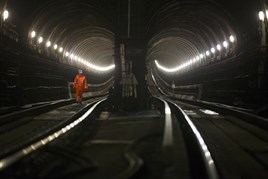The shaft led visitors down a spiral staircase to the arched passageway beyond. Sixty arches in total were filled with shops selling souvenir goods such as Thames Tunnel gin flasks, snuff boxes, coffee cans, cigar cutters and nursery ware, all to purchase as proof that you had entered the tunnel under the Thames and didn’t drown.
Fifty thousand people walked through the tunnel on the first day, and in just 15 weeks, a million people had visited. As a tourist attraction it was hugely successful, with each of them paying a penny to walk through the tunnel. But the intended alterations to allow carriages to pass through became too expensive in the end. And eventually the site also became known for attracting degenerates.
In an effort to improve the clientele, in 1852 an underwater fairground was launched, bringing fire-eaters, sword swallowers, Indian dancers and Ethiopian serenaders to the ‘Fancy Fair’, the first underwater multi-cultural festival.
But these festivities could not generate the funds that investors required from the venture (the tunnel had cost £634,000 to dig and fit out, the equivalent of more than £60 million today), and so in 1865 the tunnel’s life-long relationship with the railway began.
The tunnel was sold to the East London Railway Company (a consortium of six main line railways), with the intention of using it to carry passengers and freight by train.
In 1869, the first train ran on what had become part of the Wapping & Shadwell-New Cross Line. It was later absorbed into the London Underground system, when it became known as the East London Line. As part of LU, it was the oldest piece of infrastructure on the Underground.
Over the years, plans to build an intersection between the ELL and the Jubilee Line extension at Canada Water meant that a temporary closure of the line was needed, presenting a perfect opportunity for long-term maintenance.
A condition survey had revealed that the tunnel finishes were significantly deteriorating, and that numerous areas of seepage had occurred. LU decided that the best solution was to ‘shotcrete’ the tunnel with a 200mm-thick reinforced sprayed concrete lining, but as news of the plans spread, this became unpopular with those who wanted to conserve Brunel’s architecture.
Just three days before the work was due to begin, the tunnel was Grade 2* listed by the Heritage Secretary. A Friday afternoon (March 24 1995), with work due to begin on the following Monday morning… one can only imagine the shade of blue that the air took that weekend!
No work could begin without new sensitive requirements being met. Thirteen months of negotiations and compromise ensued, and the project budget was increased from £6.3m to an eventual £23.2m.
But a solution was finally realised. Much of the tunnel was ‘shotcreted’, but with the compromise that a section at the southern end of the tunnel was left in as original condition as possible. That effort to conserve the past might go unnoticed by the thousands of people speeding through on the Overground every day, but standing and looking up at the bricks that were saved leaves you with a real sense of history, and of the Brunels’ achievement.
On March 25 1998, exactly three years after the line had closed, it was re-opened to the public. And it remained open until December 2007, when it was closed for track laying and resignalling to allow the ELL extension to absorb it into part of the LO network. Once it re-opened on April 27 2010, the tunnel could again be used by main line trains.
And it has been ever since. The Overground has gone from transporting around 33 million passengers a year in 2007 to 136 million a year, which never would have been possible without Brunel’s pioneering Thames Tunnel.
During the three-day closure in May 2014, 4,000 people walked through the tunnel - every ticket sold out in just nine hours, without any advertising. Everyone who led the walks from Transport for London were volunteers, wanting to share one of the network’s most overlooked gems.
Those thousands of visitors are unlikely ever to regard the Thames Tunnel in quite the same way again, remembering the stories it has to tell and the innovation that Brunel gave to every underground tunnel since.
And modern engineers should take note that Brunel and Cochrane’s innovative tunnelling shield, which preceded the gargantuan tunnel boring machine, might never have existed had Brunel not once seen a tiny mollusc at work…
- This feature was published in RAIL 768 on February 18 2015














Login to comment
Comments
No comments have been made yet.